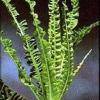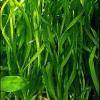Crinum calamistratum
Scientific name: Crinum calamistratum
Family: Amaryllidaceae
Maximum size reached under cultivation: 40 - 120 cm (15.75 - 47.24 inch)
014
Recommended pH range: 6.1 - 7.8
Recommended water hardness: 0 - 18°dGH (0 - 321.43ppm)
0°C 32°F30°C 86°F
Recommended temperature range: 20 - 27 °C (68 - 80.6°F)
Preferred propagation method: Bulb shoots
Native to: Africa
Growth rate: Slow
Recommended substrate: Fine gravel
Lighting requirements: Bright
Ideal placement in tank: Background
🌍 Origin
Crinum calamistratum originates from the tropical freshwater rivers of Africa, particularly in Cameroon. In the wild, it thrives in slow-moving streams with sandy or muddy substrates, where nutrient-rich conditions support the growth of its long, flowing leaves. Its natural resilience allows it to tolerate varying water conditions, including short periods of drought.
🌱 Propagation
This plant propagates mainly through bulb shoots that develop from the base of the mature bulb under optimal conditions. Once these offsets have formed roots, they can be gently separated from the mother plant and replanted in the substrate. It’s important to leave part of the bulb exposed to prevent rot. For best results, use a nutrient-rich substrate and avoid disturbing the plant once it is established.
Though it may also produce flowers and seeds, propagation via seeds is complex and recommended only for advanced aquarists. Bright lighting and soft, slightly acidic water can encourage blooming. Once flowering starts, it can follow a regular cycle, adding visual interest to the aquarium.
💧 Water Parameters
- Recommended pH range: 6.1 – 7.8
- Recommended water hardness: 0 – 18 °dGH (0 – 321.43 ppm)
- Recommended temperature range: 20 – 27 °C (68 – 80.6 °F)
⚙️ Difficulty
Medium. Crinum calamistratum requires time to establish its roots and prefers to remain undisturbed. It may react poorly to sudden changes in water chemistry or to being moved after planting. Consistent care and stable tank conditions are essential for long-term success.
📝 Short Description
Well-known for its elegant appearance, Crinum calamistratum makes an excellent background plant in aquariums. Its long, narrow, and slightly wavy leaves can grow up to 4 feet (about 122 cm), reaching the water’s surface and creating a natural, curtain-like effect. Although primarily a fully aquatic species, its bulb can survive short dry spells in the wild, giving it a degree of resilience in semi-aquatic or marsh setups.
This plant is generally ignored by herbivorous fish due to its tough leaves, making it a reliable choice even in tanks with plant-nibblers. To achieve the best growth, maintain low water flow and consider using a CO2 system to enhance nutrient uptake and root development. While Crinum calamistratum adapts well to a range of conditions, it flourishes best in a calm, stable, and well-maintained environment with occasional pruning to manage size and prevent overcrowding.

 Crinum natans
Crinum natans Crinum thaianum
Crinum thaianum